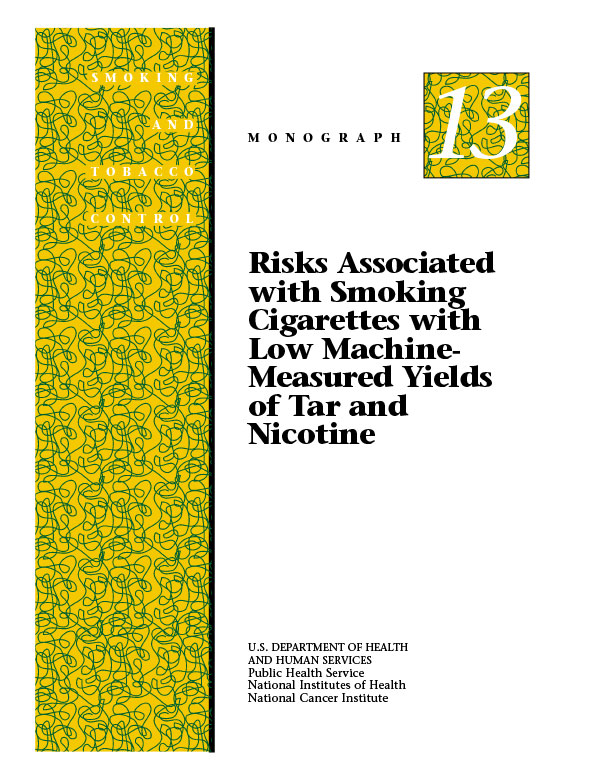
Smoking low-yield (also called low tar or light) cigarettes is associated with significant disease risks. Monograph 13 discusses the chemical composition of these cigarettes, related smoking behaviors, public perception of low-yield smoking, and how low-yield cigarettes have been marketed through the decades.
On This Page
Suggested Citation
National Cancer Institute. Risks Associated with Smoking Cigarettes with Low Machine-Measured Yields of Tar and Nicotine. Tobacco Control Monograph No. 13. Bethesda, MD: U.S. Department of Health and Human Services, National Institutes of Health, National Cancer Institute. NIH Pub. No. 02-5047, October 2001.
View Individual Chapters
Chapters and key topics covered within each chapter are listed below. Chapters generally include an introductory section, details on methodology, a chapter summary, research needs, and a reference list.
- Preface (PDF, 67 KB)
- Authors and Acknowledgments (PDF, 75 KB)
- Contents (PDF, 68 KB)
- Chapter 1. Public Health Implications of Changes in Cigarette Design and Marketing (PDF, 204 KB)
- How Did It Happen
- Compensation
- Elasticity of Demand in the Cigarette
- Marketing of Low-Yield Cigarettes
- Disease Risks
- Chapter 2. Cigarette Design (PDF, 204 KB)
- Cigarette-Yield Testing by Smoking Machine Using the FTC Protocol
- Changes in FTC Machine-Smoked Yields Over Time
- Design Changes That Reduce Standard Yields
- Compensation and Cigarette Design: Difference in Yield with Different Smoking Patterns
- More Evidence from Industry Documents Related to Compensation, Cigarette Design, and the FTC Testing Method
- Chapter 3. Compensatory Smoking of Low-Yield Cigarettes (PDF, 223 KB)
- Role of Nicotine in Maintaining Tobacco Addiction
- Biomarkers of Tobacco Smoke Exposure
- Nicotine Absorption from Cigarette Smoking
- Estimating the Extent of Compensation
- Studies of Smoking Cigarettes with Different Machine-Determined Yields: Methodological Considerations
- Short-Term Experimental Switching Studies
- Long-Term Experimental Switching Studies
- Studies of Smokers Smoking Self-Selected Brands
- Spontaneous Brand Switching
- Chapter 4. Smoking Lower Yield Cigarettes and Disease Risks (PDF, 605 KB)
- Historical Development of the Lower Yield Cigarette Issue
- Limitations of Epidemiological Studies in Examining the Risks of Low-Yield Cigarette Use
- Published Epidemiological Studies of Health Endpoints
- Biologic Implications of Compensation for Changes in Cigarette Design
- Correlation of Cigarette Brand Choice with Number of Cigarettes Smoked per Day and Duration of Smoking
- Temporal Trends in Lung Cancer and Other Diseases in Major Cohort Studies
- Temporal Trends in National Lung Cancer Death Rates and Smoking Behaviors
- Chapter 5. The Changing Cigarette: Chemical Studies and Bioassays (PDF, 269 KB)
- Identification of Carcinogens, Tumor Promoters, and Carcinogens in Tobacco Smoke
- Smoking Conditions
- Changes in Cigarette Smoke Composition with Various Design Changes
- Observations on Cigarette Smokers
- Chapter 6. Public Understanding of Risk and Reasons for Smoking Low-Yield Products (PDF, 81 KB)
- Perceptions of Light Cigarettes
- Reasons for Smoking or Switching to Light Cigarettes
- The Relationship of Switching to Quitting
- Chapter 7. Marketing Cigarettes with Low Machine- Measured Yields (PDF, 1.5 MB)
- The 1950s
- The 1960s
- The 1970s
- The 1980s

